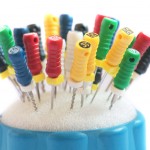
Electronic apex locators (EALs) have used in permanent teeth since the 1960s and they have been gaining in popularity. The use of EALs in the primary dentitions was proposed in 1996. The aim of this review was to compare the accuracy of EALs in primary teeth when compared to actual root canal lengths (ARCLs).
Searches were conducted in PubMed for studies comparing EAL readings with that of ARCLs. Reference lists of included studies were also searched. In vivo and in vitro studies were considered.
- 19 studies were included – 16 were in vitro, 3 had EAL readings were measured in vivo and the teeth were then extracted and ARCLs were measured in vitro.
- Meta-analysis of studies that reported mean lengths and difference in mean lengths between EAL and actual root canal length (ARCL) revealed a significant difference (P = 0.015) between the two readings. This suggests that the mean root canal length measured using the EAL was 0.109 mm shorter than the mean ARCL.
- Studies that evaluated intra-class correlation (ICC) suggested a high correlation (P < 0.0001) between the EAL and ARCL readings.
- A subgroup analysis revealed that the presence of root resorption did not affect the accuracy of EALs (P = 0.567).
The authors concluded
Within the limitations of this meta-analysis, it can be concluded that EALs offer an acceptable level of accuracy in the measurement of root canal length in primary teeth. This fact combined with a documented need to minimize radiation in children makes a compelling case for the use of EALs for WL determination in primary teeth.
Comment
This review only searched a single database. There is also no indication as to whether the study selections and data abstractions were conducted independently. In addition there is no formal assessment of study quality. The majority of the studies were undertaken in vitro. Consequently while the review suggest that EALs may be useful in primary teeth these results should be interpreted with caution.
Links
Ahmad IA, Pani SC. Accuracy of electronic apex locators in primary teeth: a meta-analysis. Int Endod J. 2014 May 23. doi: 10.1111/iej.12315. [Epub ahead of print] PubMed PMID: 24863852.
Dental Elf – 9th Jun 2014 – Electronic Apex Locators may perform better than radiography alone

[…] Dental Elf – 14th 9th Jul -2014 Review suggests that electronic apex locators may be useful in pri… […]